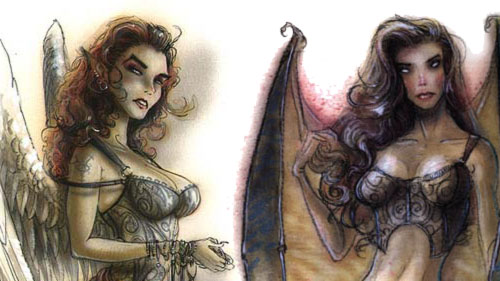With 4th Edition Dungeons & Dragons around the corner, lots of of things from previous editions will be changing around. Among these changes are some clearer delineations between Baatezu (Devils) and Tanaari (Demons). Rich Baker, developer at Wizards of the Coast, says they’re going to be tidying up the Devils to be more humanoid, more likely to use weapons and armor, as opposed to their more chaotic, bestial counterparts. That makes some sense.
Something that really caught my attention was that they’re going to be getting rid of the Erinyes as a devilish counterpart to the Succubus; apparently they’re just too similar to be two separate creatures. This is more a function of thematic drift than anything else. The Erinyes were the enforcers of Hell’s laws in Greek mythology, dragging those who created death kicking and screaming down to the underworld. The fact that they are female, along with the kind of artistic license that has lead to such silliness as chainmail bikinis, along with some rather shallow thinking by neckbearded RPG enthusiasts that equate “evil female” with “seductress” has caused the noble Erinyes to slide down to a real similarity with the more debased “sneak into your bed at night and suck out your soul” concept of the Succubus (and her counterpart, the considerably less interesting to RPG fanboys Incubus). Sword & Sorcery artists have basically three ways to draw women: child, old hag, and smoking hot sex-bunny. Nothing about the Erinyes is thematically childish or elderly, so the sultry seductress Erinyes became the graphic representation for the Furies of Hades.
I’ve personally found the corrupted version of the Erinyes to be far more interesting as a plot device. The Succubus is basically just a “gotcha” to throw at some philandering adventurer type that likes to pinch all the barmaids’ bottoms between dungeon crawls. “You lay your best line down on that maiden at the bar. Roll your Diplomacy… Yeah, she’s totally digging you. You buy her a couple drinks and she invites you back to your room.” Several failed Charisma-based Willpower saves later, the adventurer is in seriously bad shape for no particular reason. Alternately you have some manipulative devil-lady pulling the local warlord’s strings plunging the entire realm into tyranny and evil; this is more suitable work for a Devil than a Demon, the way D&D delineates things. The Succubus as an incarnation of lustful urges makes sense, but isn’t an interesting creature for adventurers to foil. The Erinyes as manipulator of greed and ambition defies the origin of the name, but is far more useful for a DM looking to challenge his players in an interesting way.
I respect that the WotC folks don’t expect to reverse this corruption of the Erinyes concept, even while saying that there may still be a role for Furies (a far less interesting name for the same thing) that are conceptually distinct from Succubi. I wonder, however, how far they’re going to take this. Is there really a serious distinction between an Orc and a Hobgoblin? How about Gnolls? Is there any substantive difference between a Kobold and a Goblin, for that matter?
A great many of the critters found in the Monster Manual and its sequels fill nearly identical roles for most purposes, and the broad pallet of choices has been a part of Dungeons & Dragons’ appeal over the years. Your kingdom isn’t being assailed just by an army of Orcs, oh no; you’re beset by a terrible alliance of Hobgoblins, Bugbears, Mongrelmen, Orcs, and Trolls. Whatever shall you do?
I’m certainly in favor of the D&D development team taking a hard look at the plethora of meanies that are presented, prefabricated, for us. An unexamined game isn’t worth publishing, to paraphrase Socrates. That said, they should always bear in mind that many of us have certain favorites that we’d the loathe to do without. Though I haven’t used an Erinyes in a D&D campaign since 3rd edition was released years ago, I would appreciate it if the editorial assumption were to improve and differentiate rather than to remove.


Now, see, if they do this, and both the Otyugh and the Neo-Otyugh stay, there’s going to be hell to pay!
I’ve always felt that the variety of Otyughs has represented a depth of biodiversity and realism in the typical Dungeons & Dragons campaign. That, and the 55 types of oozes, molds, and puddings. It’s just not D&D without killer pudding!